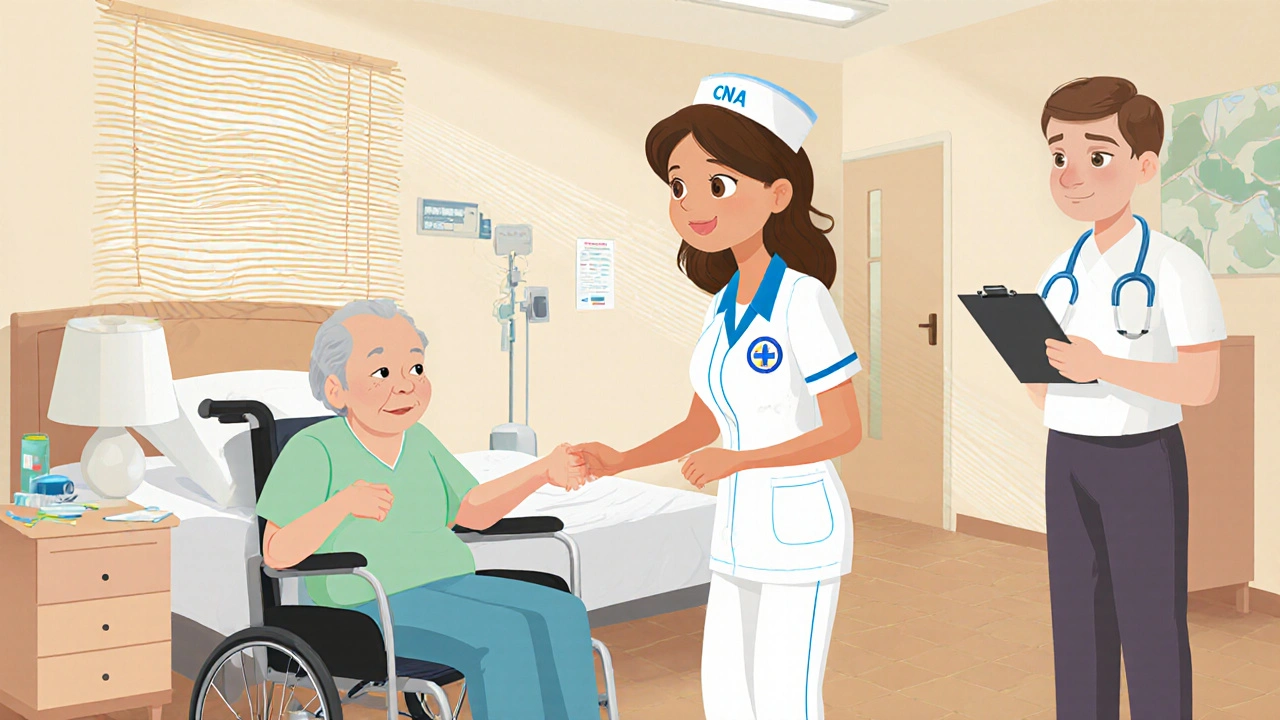Medical and Nursing Assistant Certifications: Step-by-Step Course Guide
 Nov, 5 2025
Nov, 5 2025
If you're thinking about becoming a medical or nursing assistant, you're not alone. Thousands of people in the U.S. start these careers every year because they offer fast entry into healthcare with solid pay and real job security. But getting certified isn’t just about signing up for a class. There are specific steps, requirements, and choices that can make or break your path. This guide cuts through the noise and shows you exactly what you need to do-no fluff, no sales pitches.
What’s the Difference Between a Medical Assistant and a Nursing Assistant?
People often mix up medical assistants (MAs) and nursing assistants (NAs), but they’re not the same job. A medical assistant works in clinics or doctor’s offices. You’ll do both clinical tasks-like taking blood pressure or preparing patients for exams-and administrative work, like scheduling appointments or managing records. You’re the bridge between the doctor and the patient.
A nursing assistant, often called a CNA (Certified Nursing Assistant), works mostly in hospitals or nursing homes. Your job is hands-on care: helping patients bathe, eat, walk, and use the bathroom. You report changes in their condition to nurses. It’s physically demanding but deeply rewarding.
Both roles require certification, but the training and exams are different. Medical assistants usually need to pass the CMA (Certified Medical Assistant) exam from the AAMA. Nursing assistants take the state-administered CNA competency exam.
How to Get Certified as a Medical Assistant
To become a certified medical assistant, you need three things: training, an exam, and renewal.
- Complete an accredited MA program. These are usually 9 to 12 months long and offered at community colleges, vocational schools, or online with in-person labs. Look for programs accredited by CAAHEP or ABHES-these are the only ones that qualify you to sit for the CMA exam.
- Take the CMA exam. Administered by the American Association of Medical Assistants (AAMA), this 200-question test covers anatomy, pharmacology, clinical procedures, and office management. You need to score at least 430 to pass.
- Renew every five years. You can renew by retaking the exam or earning 60 continuing education credits. Most states don’t require licensure, but certification is what employers want.
Some states, like California, have their own registration process on top of national certification. Always check your state’s health board website before enrolling.
How to Get Certified as a Nursing Assistant
Becoming a CNA is faster and often cheaper than becoming an MA. Most programs take 4 to 12 weeks.
- Enroll in a state-approved CNA training program. These are offered at community colleges, hospitals, and even some nursing homes. The program must include at least 75 hours of classroom and clinical training-48 hours of theory and 27 hours of hands-on practice, per federal guidelines.
- Pass the CNA competency exam. This has two parts: a written or oral test (usually 50-70 multiple-choice questions) and a skills evaluation. You’ll be asked to demonstrate five randomly selected tasks, like handwashing, measuring vital signs, or helping someone transfer from a bed to a wheelchair.
- Get listed on your state’s nurse aide registry. Once you pass, your name goes on the registry. Employers check this before hiring. If you’re removed for abuse or neglect, you can’t work as a CNA again.
Some states, like Florida and Texas, require a background check and fingerprinting. Others, like New York, require a tuberculosis test. Always confirm your state’s rules before starting training.

Where to Take These Courses
You have options. Not all programs are created equal.
- Community colleges offer the most affordable options, often under $1,500. Classes are in-person with clinical rotations at local hospitals.
- Vocational schools move faster. Programs can be completed in 6 weeks, but they cost more-usually $2,000 to $3,500. Check if they’re accredited.
- Online programs are flexible but require in-person clinicals. Only choose ones that partner with local healthcare facilities. Avoid any program that promises certification without hands-on training.
- Hospitals and nursing homes sometimes offer free or reduced-cost training if you agree to work for them after certification. This is a great deal if you’re sure you want to stay in that facility.
Don’t just pick the cheapest option. Look for programs with high pass rates on certification exams. Ask for their last year’s pass rate. Anything below 80% is a red flag.
Costs and Financial Aid
Training costs vary, but here’s what you can expect:
| Item | Medical Assistant | Nursing Assistant |
|---|---|---|
| Training Program | $1,200-$4,000 | $800-$2,500 |
| Exam Fee | $125-$165 | $75-$120 |
| Background Check | $50-$100 | $50-$100 |
| Uniforms/Supplies | $100-$200 | $50-$150 |
| Renewal (every 5 years) | $150 or 60 CE credits | $50-$100 |
Financial aid is available. Most programs accept FAFSA. You can also apply for grants from local health foundations, the National Health Service Corps, or your state’s workforce development agency. Some employers reimburse tuition if you commit to working for them for a year.

What Happens After Certification?
Certification is just the start. The real work begins when you walk into your first job.
Medical assistants typically earn between $38,000 and $48,000 a year, depending on location and experience. In Arizona, the average salary is $41,500. You can advance to roles like office manager, phlebotomist, or even go back to school to become a nurse.
CNAs earn between $30,000 and $38,000 annually. In nursing homes, you might work nights or weekends. But many CNAs use this job as a stepping stone to LPN or RN programs. Some hospitals even pay for tuition if you stay on staff.
Both roles are in high demand. The U.S. Bureau of Labor Statistics predicts 15% growth for medical assistants and 8% for nursing assistants through 2032-much faster than average.
Common Pitfalls to Avoid
Here’s what trips people up:
- Enrolling in a non-accredited program. You won’t be eligible for certification.
- Skipping the clinical hours. You can’t pass the skills test without real practice.
- Not studying for the exam. The CMA exam has a 60% first-time pass rate. You need to study.
- Ignoring state rules. Some states require extra paperwork or tests.
- Forgetting to renew. Letting your certification expire means you can’t work until you retake the exam.
Set a calendar reminder for renewal. Most people forget until it’s too late.
Is This Career Right for You?
Ask yourself:
- Can you stand on your feet for 8 hours straight?
- Do you handle stress well when things get chaotic?
- Are you okay with seeing people in pain or distress?
- Do you enjoy helping others, even when they’re frustrated or scared?
If you answered yes to most of these, you’re likely a good fit. These jobs aren’t glamorous, but they’re essential. And in a world where healthcare is growing, you’ll always have work.
Can I get my medical assistant certification online?
You can take the classroom portion online, but you must complete hands-on clinical training in person. No program that offers full online certification without clinicals is accredited or accepted by employers. Look for hybrid programs that partner with local clinics for your clinical hours.
How long does it take to become a CNA?
Most CNA programs take 4 to 12 weeks, depending on whether you attend full-time or part-time. Federal law requires at least 75 hours of training, including 27 hours of clinical practice. Some states require more. After completing the program, you’ll take the state exam within 30 days.
Do I need a high school diploma to become a medical assistant?
Most accredited MA programs require a high school diploma or GED. Some states allow you to take the CMA exam without one if you complete a 5-year work experience alternative, but this is rare. A diploma or GED is strongly recommended.
Can I work as a CNA without certification?
No. In every state, you must be listed on the nurse aide registry to work as a CNA. Some facilities hire trainees as “nursing aides” while they wait to take the exam, but they can’t perform certified duties like taking vitals or assisting with feeding until they’re certified.
Which certification pays more: CMA or CNA?
On average, medical assistants earn more. The national median salary for MAs is $40,000, while CNAs earn around $34,000. But pay varies by location, employer, and experience. In hospitals, CNAs with specialized skills can earn close to MA salaries.
What’s the next step after becoming a CNA or MA?
Many CNAs go on to become LPNs (Licensed Practical Nurses) or RNs (Registered Nurses). MAs often move into administrative roles or pursue degrees in nursing, health informatics, or medical coding. Both roles are excellent stepping stones into broader healthcare careers.
Jason Townsend
November 7, 2025 AT 11:29They’re hiding the real cost. The government lets these programs charge $4k then turns around and pays them to train you. You think that’s a coincidence? No. They want you in debt so you’ll stay in the system. Watch your back.
Antwan Holder
November 7, 2025 AT 13:07Every time I see someone talking about certifications like it’s salvation, I feel the weight of the machine. We’re not just becoming assistants-we’re becoming cogs. The stethoscope is a leash. The clipboard, a confession. You think you’re helping? You’re being harvested by a system that profits off your compassion. I weep for you.
Angelina Jefary
November 9, 2025 AT 02:29Correction: It’s CAAHEP or ABHES-NOT ‘CAAHEP or ABHES-these’. And you missed a comma after ‘exam’. Also, ‘you’ll be asked to demonstrate five randomly selected tasks’ should be ‘you will be asked’. Grammar matters. If you can’t write right, how can you chart vitals right?
Jennifer Kaiser
November 9, 2025 AT 06:47There’s something beautiful about these roles. Not because they pay well or are easy-but because they demand presence. You’re not just doing tasks. You’re holding space for people at their most vulnerable. That’s sacred work. No algorithm can replace the hand that wipes a brow or the voice that says ‘I’m here’. This isn’t just a job. It’s a quiet kind of heroism.
TIARA SUKMA UTAMA
November 9, 2025 AT 06:49Just do it. No need to overthink. Get certified. Work. Save money. Move on. Done.
Jasmine Oey
November 9, 2025 AT 11:19OMG I literally cried reading this. Like, I was in tears. I’m a CNA and it’s so hard and no one sees us and I just wanna scream into the void. But also… I’m so proud. Like I wear my scrubs like a crown. And yes I know I’m not an RN but I’m the real MVP of the hospital. 💕 #CNAqueen
Marissa Martin
November 9, 2025 AT 18:24I respect the effort it takes to write this. But I wonder… how many people read this and still don’t realize how much they’re being sold? I don’t comment often. But this… this made me pause.
James Winter
November 10, 2025 AT 09:25US only? What about Canada? We got our own system. You guys think you own healthcare? Nah. We do it better. Less money, more sense. Your programs are overpriced junk.
Aimee Quenneville
November 12, 2025 AT 05:03So… you’re telling me the ‘free’ training at the nursing home? Yeah, they just want you to work 60 hrs a week for 2 years after. And if you quit? They’ll sue you. I did it. Survived. Still hate them. But hey… I got my certs. 🤷♀️
Cynthia Lamont
November 12, 2025 AT 21:28Wait. You said ‘some states require extra paperwork’ but didn’t list which ones. That’s irresponsible. Florida requires 120 hours. New York requires 100. California requires a TB test AND a background check AND a fingerprint card. You’re giving half-baked info. People will fail. You’re literally endangering careers. Fix this.